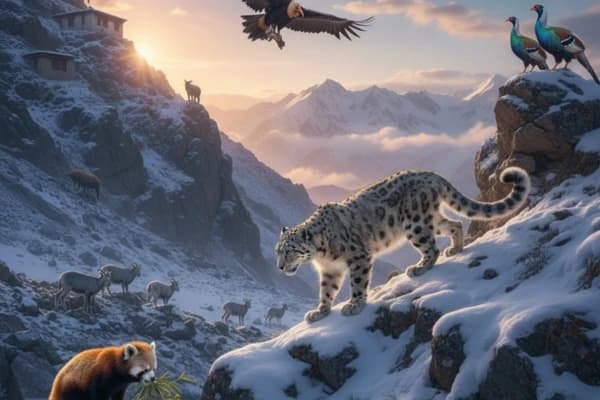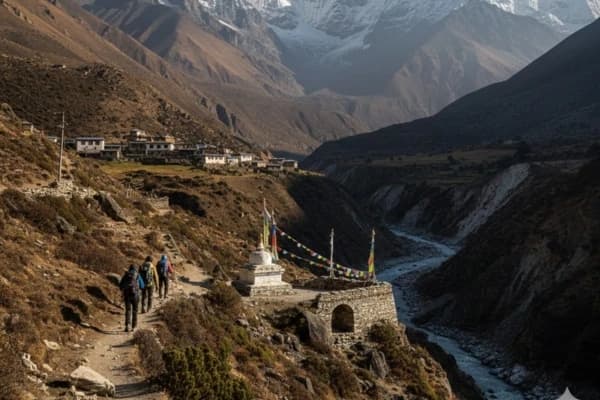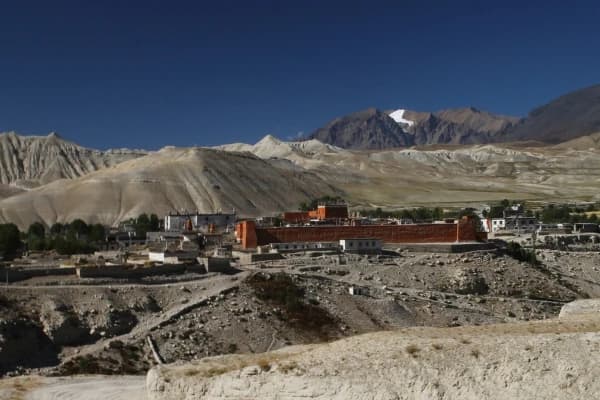Dashain is Nepal's most adored and honored festival, bringing together families, friends, and communities locally and beyond. This celebration, also called Vijaya Dashami, is full of customs, rituals, and festive get-togethers and represents the victory of good over evil. It’s more than a religious celebration. Dashain is a national holiday season, a cultural event, and a reason to travel home.
The word "Dashain" comes from "Dash," which means ten. But here's the beautiful part—it's not just about counting days. It's about celebrating the most essential message humans have ever shared: that light will always find a way to win, no matter how dark things get.
The Heart of the Story: Good Always Wins
Religiously, Dashain celebrates two incredible victories that happened thousands of years ago but still inspire people today. Goddess Durga's victory over the monster Mahishasura demonstrates the force of divine feminine energy. Additionally, it honors the triumph of good over evil by commemorating Lord Rama's victory over Ravana. Hindu epics like the Devi Mahatmya and the Ramayana are the source of these tales.
During these 15 days, an entire country stops what it's doing to celebrate together. Government offices close, businesses shut down, and even the busiest, most stressed-out people take time off to reconnect with what matters.
Dashain unites families separated by work, distance, or life's complications. Old arguments get forgotten. New relationships receive blessings. From cities to mountain villages, streets fill with kites, swings, feasts, and blessings. It’s a time of mass travel as people return home, making it Nepal’s largest festival and social event of the year.
The whole country takes this collective deep breath and remembers that at the end of the day, we're all just people who want to love and be loved.
Origin of Dashain
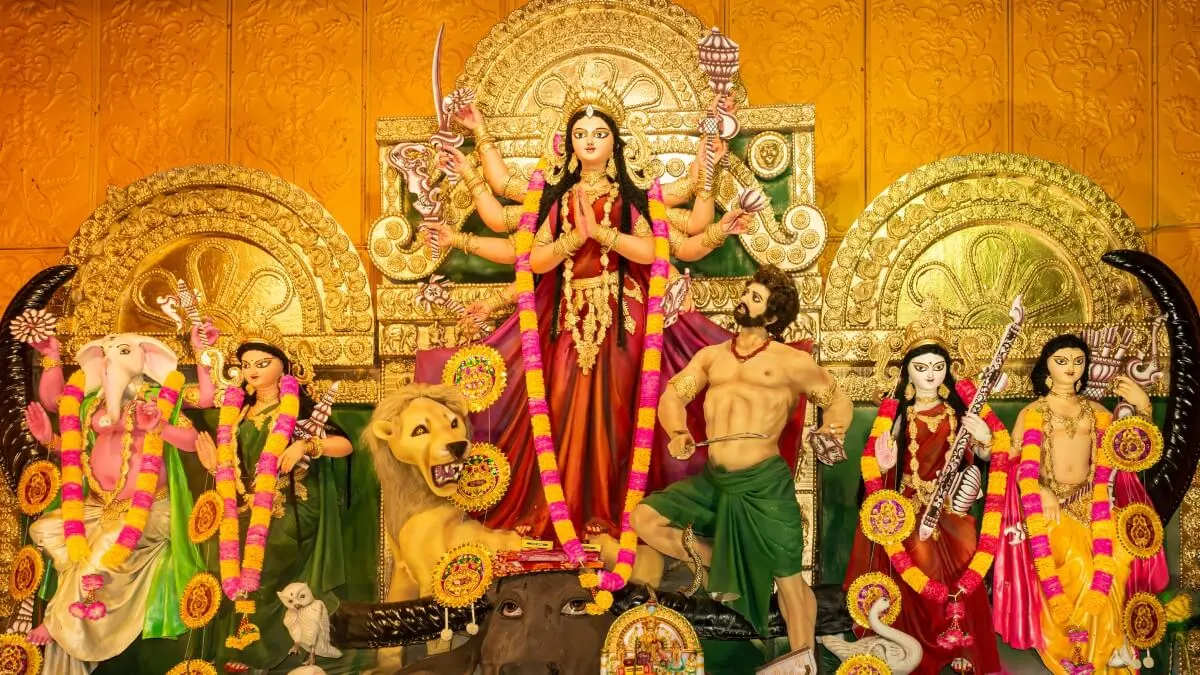
The origins of Dashain go way, way back; we're talking thousands of years of tradition that's been lovingly passed down from grandparents to grandchildren, generation after generation.
Legend says that they did something amazing when the buffalo demon Mahisasura became so incredibly powerful that even the gods were scared. Instead of giving up, they combined all their divine powers to create the ultimate warrior goddess—Durga, the fiercest, most beautiful, and powerful woman you can imagine, armed with the strength of every god and goddess combined.
For nine long days and nights, Durga fought this seemingly unbeatable demon. Each day brought new challenges, new weapons, new divine powers. But she never gave up. And on that tenth day the day we now call Vijaya Dashami, she finally emerged victorious, restoring peace and hope to the entire world.
Dashain also honors Lord Rama's incredible victory over Ravana. When Sita was kidnapped and taken far from home, Rama didn't just sit around feeling sorry for himself. He embarked on this epic journey, gathered allies (including the amazing monkey god Hanuman), and fought until he could bring his beloved home safely.
What's beautiful is that both these victories happened on the same day, the tenth day, which is why this particular day feels so incredibly powerful and special.
When Is Dashain Celebrated and How Long Does It Last?
In 2025, Dashain starts on September 22 and concludes on October 6, with key days such as Ghatasthapana (the first day) when sacred grass called Jamara is sown, and Vijaya Dashami (the tenth day), when elders place tika on younger relatives' foreheads as blessings.
Dashain in the Lunar Calendar (Ashwin/Kartik Months)
Dashain doesn't follow our regular calendar. The festival typically happens between late September and early November, during what the Nepali calendar (Bikram Sambat) calls the months of Ashwin and Kartik.
The dates change yearly based on the moon's phases, meaning each Dashain celebration is unique. There's something extraordinary about a festival that flows with natural rhythms rather than fighting against them. These months are also famous for trekking.
Duration: 15-Day Festival Overview
Because of the name, many people believe Dashain lasts ten days, but the festival takes over fifteen amazing days. It's similar to the longest, most significant party in the world, where the happiness grows gradually and exquisitely.
The first nine days are Navaratra, and they're like the opening acts of a fantastic concert, building excitement and preparing everyone for the main event. Then comes the spectacular climax from days 10-15, when the real celebrations explode into life.
It gives everyone time to soak in the experience. It starts quietly with personal rituals and family preparations, builds to the magnificent peak of Vijaya Dashami, and then continues with visits, feasts, and community celebrations. Dashain spans 15 days, each with its significance. While some days are celebrated quietly at home, others like Ghatasthapana, Fulpati, Maha Ashtami, Maha Navami, Vijaya Dashami, and Kojagrat Purnima involve national observances and rituals.
Dashain Dates in Nepal 2025
If you're thinking about visiting Nepal then Dashain 2025 is from September 22- October 6, 2025.
|
Day |
Nepali Date |
English Date |
|---|---|---|
|
Day 1 – Ghatasthapana |
5 Ashwin 2082 BS |
Monday, September 22, 2025 |
|
Day 7 – Fulpati |
11 Ashwin 2082 |
Sunday, September 28, 2025 |
|
Day 8 – Maha Ashtami |
12 Ashwin 2082 |
Monday, September 29, 2025 |
|
Day 9 – Maha Navami |
13 Ashwin 2082 |
Tuesday, September 30, 2025 |
|
Day 10 – Vijaya Dashami (Dashain Tika) |
14 Ashwin 2082 |
Wednesday, October 1, 2025 |
|
Day 15 – Kojagrat Purnima |
19 Ashwin 2082 |
Sunday, October 5 or Monday October 6, 2025Ending: Monday, October 6, 2025 |
What Are the 15 Days of Dashain and Their Rituals?
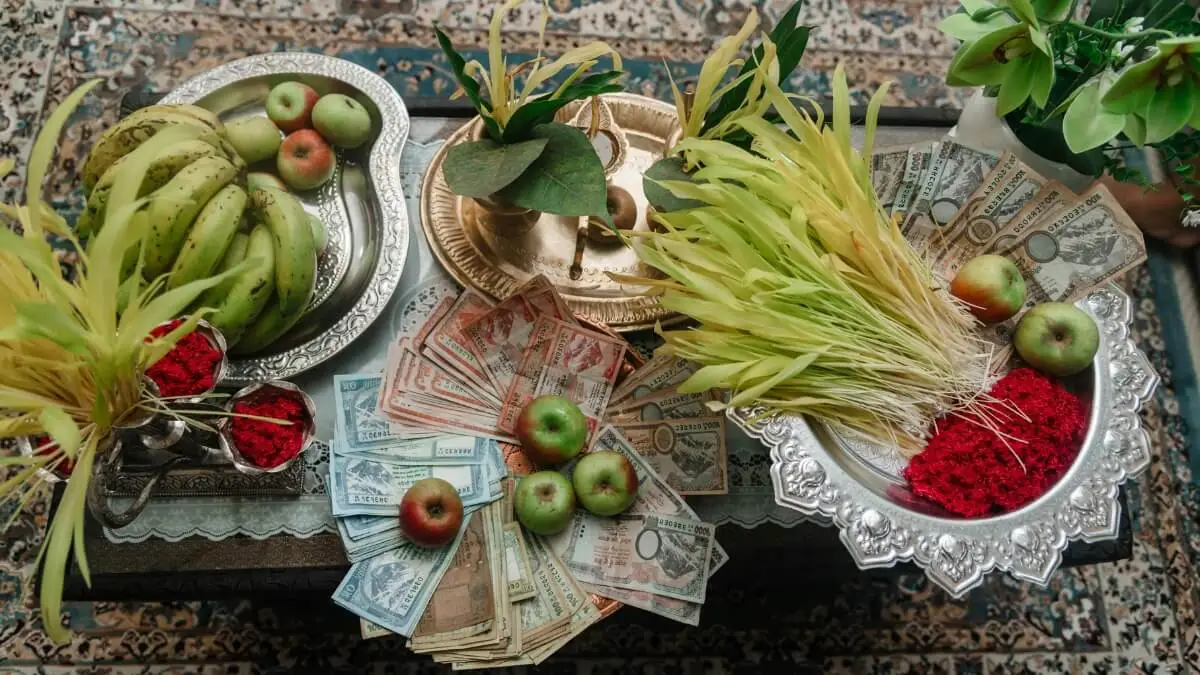
Meaningful customs that emphasize the festival's spiritual and cultural value are observed during the 15 days of Dashain. From the planting of sacred seeds to elaborate processions, fervent devotion, and happy family get-togethers, every day has its own special customs.
Day 1 – Ghatasthapana: Planting Seeds of Hope
Dashain begins in the most beautiful, quiet way imaginable. In homes across Nepal, families gather to plant sacred barley and maize seeds called "Jamara" in special dark rooms. These aren't just any seeds, they're watered with holy water and tended with daily prayers and so much love.
As these seeds sprout and grow throughout the festival, they represent everything good we want in life: new beginnings, prosperity, growth, and the amazing power of life to flourish even in darkness.
The tender green shoots that emerge will later be placed behind family members' ears during the tika ceremony, carrying with them all the blessings, hopes, and dreams that were planted on this first, sacred day.
Day 7 – Fulpati: The Procession of Joy
Fulpati which literally means "flowers and leaves" brings one of the most colorful, joyful processions you'll ever see. Sacred items including banana stalks, jamara, and flowers make their traditional journey from Gorkha to Kathmandu's historic Hanuman Dhoka Palace.
Hundreds of people in traditional dress, carrying these sacred offerings, while traditional music fills the streets. The whole city seems to be getting ready for the greatest party in the world.
Day 8 – Maha Ashtami: Honoring the Divine Feminine
On this day, thousands of devotees fill the temples, bringing flowers, fruits, and prayers as Goddess Durga is worshiped in her most potent form.
While traditional ceremonies include animal sacrifices at certain temples, many families and communities now focus on the spiritual heart of the day offering flowers, prayers, and gratitude. It honors the divine power that protects and nurtures all life.
Day 9 – Maha Navami: Blessing Everything That Serves Us
People bless and pay respect to their cars, tools, and even kitchenware on Maha Navami. Beautiful flower garlands cover cars, marigolds adorn bicycles, and yes, even kitchen knives are treated ceremoniously.
It's a reminder that, when we approach them with the proper attitude, even the most commonplace items can become sacred. It is deserving of respect and devotion.
Day 10 – Vijaya Dashami: The Day That Changes Everything
The whole country joins together in a huge, loving family celebration on Vijaya Dashami. You'll find yourself smiling without any reason since the joy is so contagious.
Families gather for the sacred tika ceremony early in the morning. Elders gently apply a mixture of rice, yogurt, and vermillion, together with the green shoots of jamara that have been growing since the beginning, to the foreheads of younger family members. However, this is more than just a tradition; it's a sincere time of blessing, love, and bonding.
Everyone dresses in their best, most colorful attire, families celebrate the most amazing feasts you can imagine, and children receive gifts and money. You will never forget the happiness on their faces when they finally get to spend time together.
Day 15 – Kojagrat Purnima: Ending with Abundance
Dashain concludes in the most beautiful way possible on Kojagrat Purnima, when families honor Goddess Laxmi (the goddess of wealth and prosperity) under the full moon's gentle light. Homes are cleaned until they sparkle and decorated with lights to welcome her blessings.
Families have a sweet custom of staying up all night playing games and cards because they think that Laxmi only comes to houses where people are awake and moving. It's similar to the most significant sleepover in the world, where staying up late is a means of attracting plenty into your life rather than just having fun.
These days encapsulate Dashain's core group activities and spiritual teachings. Significant national events and ceremonies usually take place on these key days, while prayers, private rites, and preparations are still carried out on the other days. Because of this, the days that fall between these highlights are usually more relaxed or focused, with the goal of sustaining worship, strengthening the Jamara, and building anticipation for the festival's primary events.
Dashain and Trekking Season in Nepal
In addition to being Nepal's largest celebration, Dashain is among the best seasons for trekking in the Himalayas. Beautiful scenery, lively village celebrations, and clear skies are all in store. Whether you're seeking short hikes or high-altitude adventures, here are the best treks to do during Dashain 2025, perfect for blending culture with nature.
|
Destination |
Why Trek Here in Dashain? |
|---|---|
|
Short, family-friendly, cultural exposure |
|
| Off-the-beaten-path, suitable for monsoon-avoiders | |
| Post-earthquake revival energy, great views | |
|
Crisp autumn mountain views |
|
| Religious + trekking combo during festival season | |
|
Quiet trails, crystal-clear mountain views, peaceful Dashain atmosphere |
|
| Late September to early November (Dashain season) offers crystal-clear skies, ideal temperatures, and dry trails—perfect for the high passes of Manaslu. |
Ready to combine Dashain with a trek adventure?
Discover our Dashain Special Featured Trekking Packages here and secure your spot for 2025 now!
What Are the Traditional Foods and Activities During Dashain?
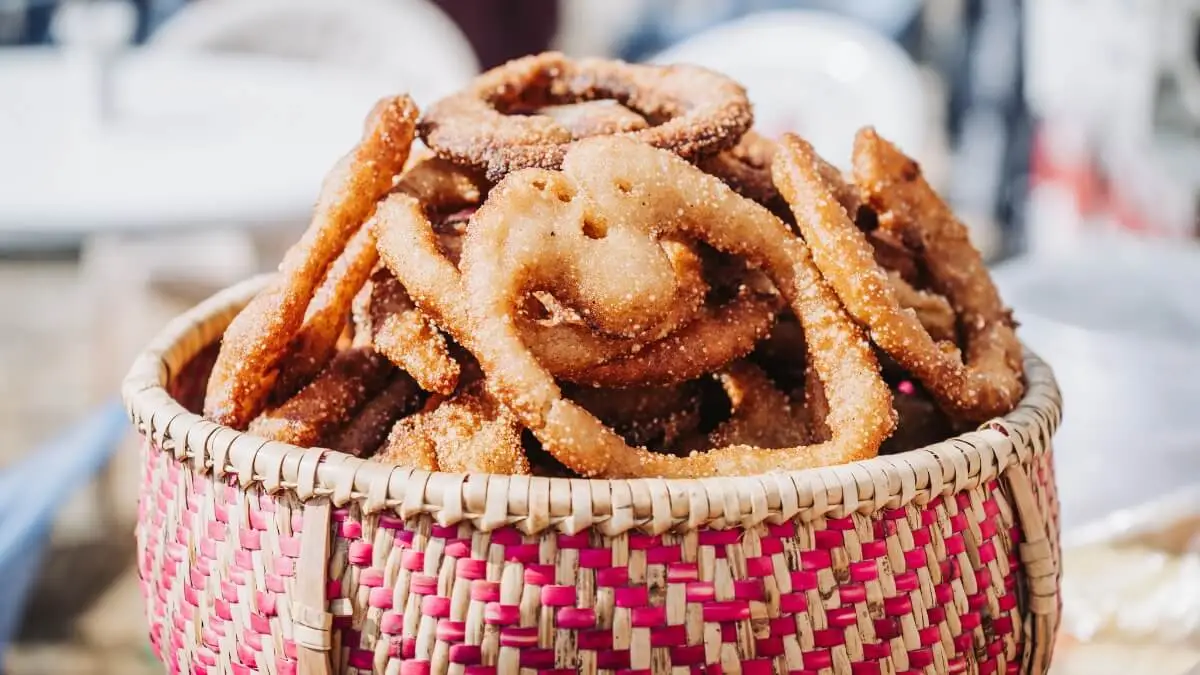
Dashain food aren't just meals; they're elaborate feasts that bring families together around tables groaning under the weight of traditional delicacies that have been prepared with incredible care and generations of family secrets.
- Mutton Curry (The Star of Every Table): The rich, aromatic mutton curry that appears at every Dashain feast is incredible. Simmered with spices that fill the house with the most amazing smells. Every family has their own special recipe, usually passed down from grandmother to mother to daughter, making each version unique and special.
- Selroti (Heaven in Bread Form): Oh my goodness, the smell of Selroti during Dashain is absolutely incredible. This traditional ring-shaped rice bread is sweet and crispy, made completely by hand before being deep-fried to golden perfection. Every family makes huge batches to share with neighbors, friends, and anyone lucky enough to visit.
- Kheer (Sweetness That Speaks to the Soul): This creamy, dreamy rice pudding made with milk, sugar, and cardamom represents prosperity and all the sweetness life has to offer. The gentle, comforting sweetness perfectly balances the rich, savory dishes and creates this perfect harmony of flavors that makes every bite feel like a warm hug.
- Achar (Little Explosions of Flavor): These are the pickles that transform every bite. From spicy tomato and sesame combinations to tangy radish and cucumber varieties, each type of achar adds its own personality to the meal, creating layers of taste that keep surprising you.
Dashain reflects the festival's celebration of prosperity and the triumph of good over everything difficult in life. Families who might eat simply throughout the year save up to create these incredible feasts, making the food itself part of the celebration.
What You'll Experience During Dashain
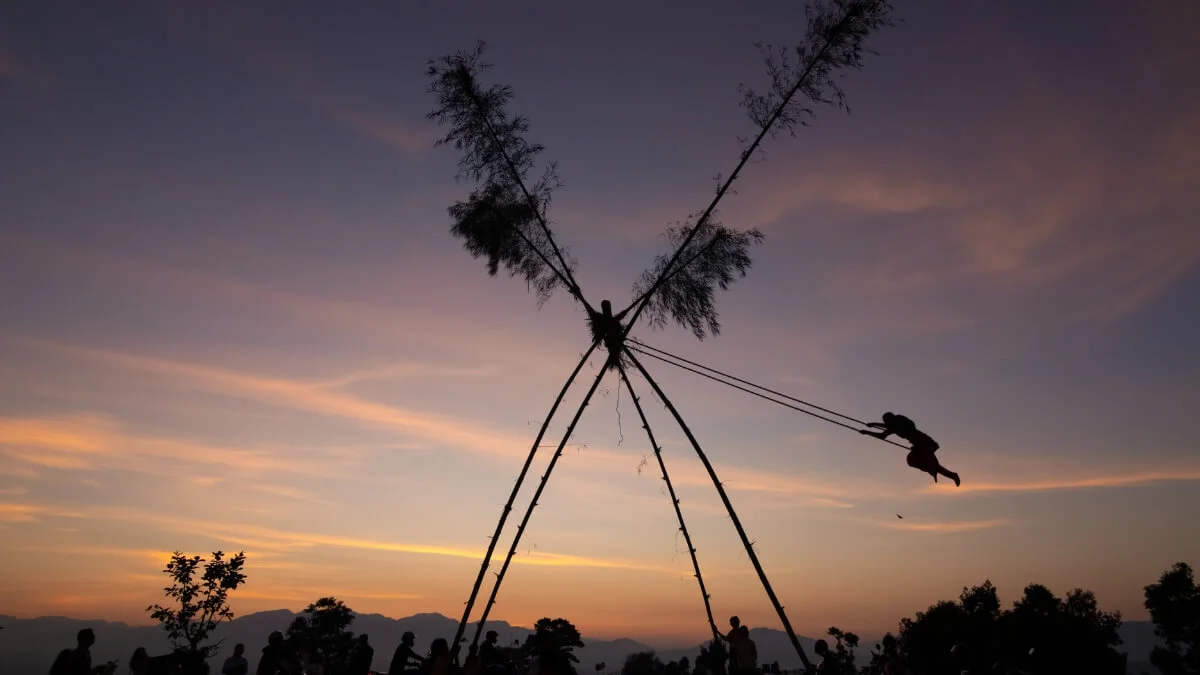
- Linge Ping (Swings That Touch the Sky): All over Nepal, you'll see these amazing, colorful bamboo swings called Linge Ping. Adults and children alternately swing high into the air while their laughter mingles with age-old tunes that have been performed for many centuries. These swings are thought to offer luck and pure delight to everybody who uses them, so they're not only for fun.
If you get a chance to try one, go for it! The locals will absolutely love teaching you their traditional swinging songs, and there's something incredibly freeing about soaring through the air while surrounded by mountain views and festival joy. - Weather That Feels Like a Gift: It's almost unbelievable how beautiful October is in Nepal. The air is so clean and fresh that it feels like breathing pure energy, the temperatures are ideal for celebration and trekking, and the sky is an unending expanse of crystal-clear blue.
This time of year is ideal for photography and mountain watching because the Himalayas are so clearly visible. The weather itself seems to have joined in the festivities! - Kites Dancing in the Sky: Look up during Dashain and prepare to be amazed.The sky is filled with hundreds of colorful kites dancing in the wind like confetti against the blue sky. Kite flying is a beloved Dashain tradition, with friendly competitions, battles, and pure joy happening on rooftops across the entire country.
Music That Makes Hearts Sing
You'll hear children singing festival songs while playing on swings, families harmonizing during tika ceremonies, and entire communities gathering for performances that tell ancient stories through music and dance.
People dance and tell the stories of Durga's victory and Rama's triumph, with colorful costumes and movements so full of energy that they capture the festival's incredible spirit.
Visit Nepal During Dashain Festival
Visiting Nepal on Dashain, it's like being invited into Nepali culture's very heart and soul. You're not watching from the sidelines; you're becoming part of a celebration that defines what it means to be human in the most beautiful way possible.
Best Cultural Experiences for Tourists
- Temple Adventures: During Dashain, Nepal's temples transform into these incredible centers of energy and devotion. Places like Pashupatinath and Dakshinkali buzz with thousands of devotees, ceremonies that'll give you goosebumps, and an atmosphere so electric with faith and joy that you can literally feel it in the air.
- Family Magic: Many Nepali families open their homes and hearts to visitors during Dashain, inviting you to join their most sacred celebrations. Participating in tika ceremonies, sharing those incredible festival meals, and experiencing the legendary warmth of Nepali hospitality create memories that'll stay with you for the rest of your life.
- Market Adventures: Dashain markets are like stepping into the most colorful, fragrant, joyful sensory experience imaginable. Brilliant decorations, traditional foods you've never seen, gorgeous festival clothing, and ceremonial items create shopping experiences that are adventures in themselves.
You can also enjoy our Kathmandu Valley Day Tour for better Dashain Experience.
Travel Tips: Timing, Etiquette, Do’s and Don’ts
- Perfect Timing: Arrive a few days early to feel the festive build-up and to get your trekking permits before Dashain office closures. It's a busy season, and early arrival ensures smooth logistics and a deeper cultural experience.
Book Early for Your Dashain Trek Now!
Being Respectful and Welcoming:
- Do accept tika and jamara graciously if someone offers them. It's a genuine blessing and an absolute honor
- Do dress modestly when visiting temples and joining ceremonies. It shows respect for something sacred
- Do remove your shoes before entering homes and religious spaces. It's basic courtesy that people appreciate
- Don't interrupt prayer ceremonies or religious rituals. These are sacred moments
- Don't use your left hand for receiving gifts or food. The right hand is considered more respectful
- Don't point your feet toward religious objects or people. It's considered disrespectful
Remember that Dashain is important to Nepalis. Treat everything with sincere inquiry, respect for customs you may not fully comprehend, and gratitude for being a part of something unique.
Final Thoughts
Dashain is the gateway to the spirit of Nepal. It provides a profound experience that transforms your perception of happiness, family, and the celebration of life. Memories made during this amazing festival are enduring because of its warmth, joy, and spiritual depth.
Ready to Celebrate Dashain 2025 with Nepal Gateway Trekking?
Join our immersive Dashain Tours 2025 meet real Nepali families, witness ancient rituals, and trek through breathtaking autumn trails. Contact us now and experience Nepal like never before.
Frequently Asked Questions (FAQs)
Is Dashain only celebrated by Hindus in Nepal?
No, Dashain is a national festival celebrated across religions, including Buddhists and secular communities.
What is the difference between Dashain and Tihar?
Dashain is about Durga and family reunions whereas Tihar is held shortly after, honors animals, Goddess Laxmi, and the bond between brothers and sisters.
Why is Dashain such a big deal for Nepalese living abroad?
It’s the main time to return home and reconnect with culture, family, and faith.
Can tourists participate in Dashain celebrations respectfully?
Absolutely, tourists can participate in Dashain celebrations. You can observe local etiquette, and you’ll be warmly welcomed into homes and rituals.
Are shops and trekking routes closed during Dashain?
Some services close on key days like Vijaya Dashami. But trekking routes remain open and guides are available with prior arrangement.
How is trekking different during the Dashain season?
Trekking during Dashain season combines great weather with cultural richness. Villages are festive, trails are lively, and teahouses often have special celebrations.
Is it necessary to book treks in advance for Dashain?
Yes, Dashain is a busy travel period, so it’s best to book early to secure guides, permits, and accommodation.
Which treks are best suited for families during Dashain?
Ghorepani Poon Hill, Langtang Valley, and Ghandruk Village are short Family-Friendly Treks during Dashain.
Are there cultural events or festivals I can witness on trek routes?
Yes, especially in Ghandruk, Kagbeni, and Lo Manthang, where local Dashain traditions come alive with music, dancing, and rituals.
Can I combine a trek with other Dashain travel experiences?
Yes, you can combine short treks with visits to places like Bhaktapur, Bandipur, or even Chitwan National Park.
Is Upper Mustang a good trek during Dashain?
Yes, the Upper Mustang Trek is a good trek during Dashain. The weather is dry, the skies are clear, and the region’s Tibetan-influenced culture offers a unique Dashain vibe.
Do teahouses offer special meals or festivals during Dashain?
Yes, many do offer special meals during Dashain. You might get to try goat curry, sel roti, and other Dashain specialties, especially in family-run lodges.


